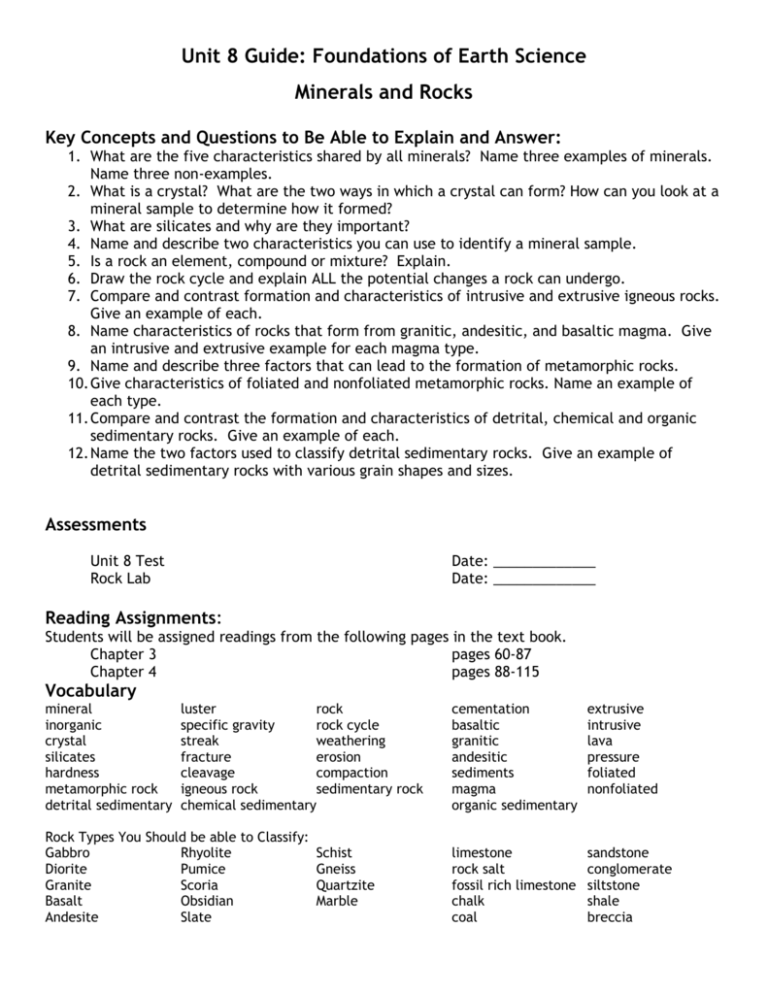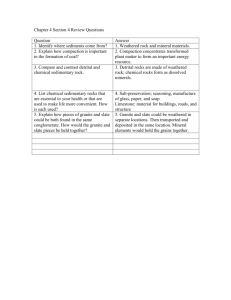Unit 8 Guide Foundations doc
advertisement

Unit 8 Guide: Foundations of Earth Science Minerals and Rocks Key Concepts and Questions to Be Able to Explain and Answer: 1. What are the five characteristics shared by all minerals? Name three examples of minerals. Name three non-examples. 2. What is a crystal? What are the two ways in which a crystal can form? How can you look at a mineral sample to determine how it formed? 3. What are silicates and why are they important? 4. Name and describe two characteristics you can use to identify a mineral sample. 5. Is a rock an element, compound or mixture? Explain. 6. Draw the rock cycle and explain ALL the potential changes a rock can undergo. 7. Compare and contrast formation and characteristics of intrusive and extrusive igneous rocks. Give an example of each. 8. Name characteristics of rocks that form from granitic, andesitic, and basaltic magma. Give an intrusive and extrusive example for each magma type. 9. Name and describe three factors that can lead to the formation of metamorphic rocks. 10. Give characteristics of foliated and nonfoliated metamorphic rocks. Name an example of each type. 11. Compare and contrast the formation and characteristics of detrital, chemical and organic sedimentary rocks. Give an example of each. 12. Name the two factors used to classify detrital sedimentary rocks. Give an example of detrital sedimentary rocks with various grain shapes and sizes. Assessments Unit 8 Test Rock Lab Date: _____________ Date: _____________ Reading Assignments: Students will be assigned readings from the following pages in the text book. Chapter 3 pages 60-87 Chapter 4 pages 88-115 Vocabulary mineral inorganic crystal silicates hardness metamorphic rock detrital sedimentary luster rock specific gravity rock cycle streak weathering fracture erosion cleavage compaction igneous rock sedimentary rock chemical sedimentary Rock Types You Should be able to Classify: Gabbro Rhyolite Diorite Pumice Granite Scoria Basalt Obsidian Andesite Slate Schist Gneiss Quartzite Marble cementation basaltic granitic andesitic sediments magma organic sedimentary extrusive intrusive lava pressure foliated nonfoliated limestone rock salt fossil rich limestone chalk coal sandstone conglomerate siltstone shale breccia How to Receive up to 5 Bonus Points for Completing the Unit Guide: 1. Type or handwrite an answer to each Unit Objective Question. Unless stated in the question, all answers must be given in complete sentences. 2. Define each of the vocabulary terms. Do not just copy the definition out of the book’s glossary. Use and add on to the definition we developed in class by giving additional information and examples of each word. 3. Unit Guides must be turned in on test day and will NOT be accepted late. You must answer ALL unit objective questions and define ALL terms. 4. Mrs. Froehlich will review your Unit Guide and determine the number of bonus points to be added to your test. Bonus points will be granted based on correctness and completeness of answers and definitions.







